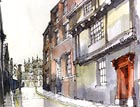Choosing doors and doorcases
Architect and broadcaster Ptolemy Dean champions the importance of choosing the right door and doorcase


Owengate in Durham, with its glorious and unfolding view of the cathedral, is one of Europe's great streets, and an intimidating place to design a new front door. And yet here is one of the most charming little front door cases that one can imagine. With its scrolly carved bracketed canopy and neatly accommodated steps, it provides protection from the elements; sufficient certainly for its owner to fumble for a key. In detail, the top ledge, cut in a manner reminiscent of pie pastry in a faintly Baroque pattern, is as crisp as a potato chip. This design is both elegant and solid, grand and modest. It does not compete with or distract from the view of Durham Cathedral, but it provides a point of interest on the way. There are important lessons here. Certainly, one wants something that marks the point of entry in a way that is dignified but not too flashy. It is hard to do. The 18th century, from which this door dates, was a marvellous period for front doors, and tens of thousands of modest houses with otherwise plain façades were given simple doorcases, such as this. Where there was room, a fanlight might be added above the door to light the hallway behind. It sounds so obvious, and yet there is an infinite variety in the designs. Sometimes it is a reeded, sometimes it is Gothic, more often it is Classical. Georgian cities such as Dublin, Edinburgh and Bath now promote themselves with poster prints of their assorted front doors (and, if Liverpool looked after its Georgian houses better, it could do the same). These doors and their surrounds are usually made of painted softwood just planted onto the building's façade. They are therefore cheap to make, which means that we could still afford to add timber porches and door cases today, even with some degree of carving, if we wanted to. I was once asked to turn a dreary back door of a school boarding house in Westminster into its front door. Budgets were tight, but we added a simple painted timber canopy porch, supported on two carved timber brackets. The building was transformed. Nowadays, when people want to make a splash, they replace their old doors with new doors, the replacements often of uPVC. The plastic frame can accept a sheet of glass, or, if a 'traditional' design is wanted, the glass can be substituted with a solid plastic section with fake panels. These standard factory made products add nothing special to a house, but provide good draught proofing until the rubber seals degenerate, which, in time, they inevitably will. And when the door handle locks and jams, the whole unit will need to be renewed, as no one can ever mend uPVC. How much better it would be if all the energy involved with these modern doors could be funnelled into making new doors and porches out of wood. With a rise in demand, there would be craftsmen available and the prices would come down. There would be a renaissance in the art of the front door. Let us long for that day.
Sign up for the Country Life Newsletter
Exquisite houses, the beauty of Nature, and how to get the most from your life, straight to your inbox.
Country Life is unlike any other magazine: the only glossy weekly on the newsstand and the only magazine that has been guest-edited by HRH The King not once, but twice. It is a celebration of modern rural life and all its diverse joys and pleasures — that was first published in Queen Victoria's Diamond Jubilee year. Our eclectic mixture of witty and informative content — from the most up-to-date property news and commentary and a coveted glimpse inside some of the UK's best houses and gardens, to gardening, the arts and interior design, written by experts in their field — still cannot be found in print or online, anywhere else.
-
 About time: The fastest and slowest moving housing markets revealed
About time: The fastest and slowest moving housing markets revealedNew research by Zoopla has shown where it's easy to sell and where it will take quite a while to find a buyer.
By Annabel Dixon Published
-
 Betty is the first dog to scale all of Scotland’s hundreds of mountains and hills
Betty is the first dog to scale all of Scotland’s hundreds of mountains and hillsFewer than 100 people have ever completed Betty's ‘full house’ of Scottish summits — and she was fuelled by more than 800 hard boiled eggs.
By Annunciata Elwes Published
